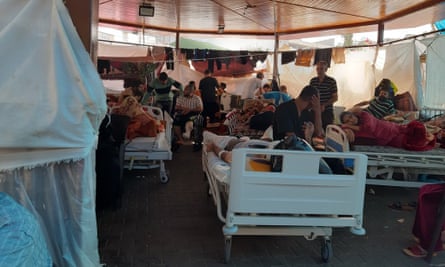A London surgeon has described witnessing a “massacre unfold” during 43 days spent under bombardment in Gaza, saying the destruction of the Palestinian health system was a military objective of the war.
Speaking at a press conference in London, Prof Ghassan Abu-Sittah, a plastic and reconstructive surgeon, who will later give evidence to Scotland Yard, told of horrific scenes at al-Ahli Arab and Dar al-Shifa hospitals as they ceased to function and said he witnessed the use of white phosphorus munitions. The Israel Defense Forces (IDF) have denied using such weapons.
“Having seen this massacre unfold, the creation of an uninhabitable Gaza Strip was the aim and the destruction of all the components of modern life at which the health system lies was the main military objective,” said Abu-Sittah, who has a practice in west London and has worked in Gaza since 2009, as well as in wars across Yemen, Iraq, Syria and Lebanon.
A picture of damaged buildings taken by Abu-Sittah. Photograph: Ghassan Abu-Sittah
When asked about Israel’s claims of being at war with Hamas and its denial of targeting civilians in Gaza, he said: “Statistically, it appears that the numbers tell a different story.”
Claims of the use of white phosphorus in Gaza were also made by Human Rights Watch in October, while Amnesty International claimed to have evidence of its use in southern Lebanon. The IDF called the Human Rights Watch claim “unequivocally false”, adding: “The IDF has not deployed the use of the such munitions.”
Since a Hamas attack on Israel in which 1,200 people were killed and 240 taken hostage, Israel’s retaliatory bombardment has killed more than 16,000 civilians and injured 34,000. Despite the two-day extension of a truce announced on Monday, Abu-Sittah said the recent supply of medicine, food and water did not come close to dealing with the humanitarian problems.
 People sit on hospital beds in Gaza. Photograph: Ghassan Abu-Sittah
People sit on hospital beds in Gaza. Photograph: Ghassan Abu-Sittah
For six weeks he shuttled between Gaza’s hospitals. It immediately became apparent about half of the wounded would be children, he said. As time passed, medical workers went from treating patients suffering from blast injuries to those exposed to fragmentary missiles, sniper injuries and incendiary bombs – which Israel has denied using.
“We started seeing phosphorus burns,” Abu-Sittah told the press conference. “I had treated white phosphorus burns in the Gaza Strip during the 2009 war – it was very familiar with the very characteristic injuries and burns that they make.”
The IDF said: “The IDF uses only legal weapons and ammunition. The primary smokescreen shells used by the IDF do not contain white phosphorus.
 A mangled wheelchair sits among debris. Photograph: Ghassan Abu-Sittah
A mangled wheelchair sits among debris. Photograph: Ghassan Abu-Sittah
“Like many western militaries, the IDF possess smokescreen shells that include white phosphorus that are legal under international law. These shells are used by the IDF for creating smokescreens and not for targeting or causing fires, and are not defined under law as incendiary weapons.”
On the day al-Ahli Arab hospital, the oldest in Gaza, was attacked on 18 October, Abu-Sittah heard the whistling sound of a missile followed by an explosion. The blast killed hundreds and sparked protests across the Middle East as Israel and Hamas traded blame over the deadly blast.
 People seen taking shelter in a picture taken by Abu-Sittah. Photograph: Ghassan Abu-Sittah
People seen taking shelter in a picture taken by Abu-Sittah. Photograph: Ghassan Abu-Sittah
It was a litmus test, Abu-Sittah said, for what the IDF had planned to do to the rest of the health system. Following the attack four paediatric hospitals were targeted, he said. Last week Israel targeted the al-Awda and Indonesian hospitals in Gaza’s north, and arrested Shifa hospital’s director and several medics.
“There’s a pattern in which the aim of this war was to turn Gaza into an uninhabitable death war zone,” said Abu-Sittah, who witnessed a phone call from the IDF warning the al-Awda hospital’s medical director to evacuate otherwise the hospital would be targeted.
Over time medical supplies dwindled and painful procedures were performed without anaesthetic before operating was no longer possible. Patients’ wounds were cleaned with store-bought washing liquid and vinegar, said Abu-Sittah, while others became infected with larvae.
Since leaving Gaza 10 days ago, Abu-Sittah said he felt an overwhelming sense of guilt for those left behind.
“My fear is even those who are steadfast enough to stay will eventually leave on their own and we will have what the Israelis want, which is another 1948,” he said.
“This war is the continuation of the 1948 Nakba.”
https://www.theguardian.com/world/2023/nov/27/london-surgeon-says-saw-massacre-unfold-working-gaza-hospitals



